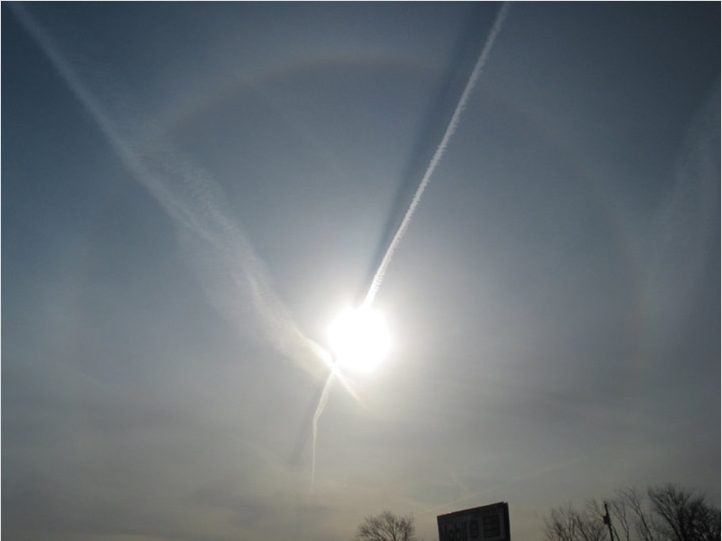22 degree halo and contrail shadow
The Fascinating Phenomenon of the 22 Degree Halo and Contrail Shadow
Have you ever looked up at the sky and noticed a captivating ring of light encircling the sun or moon? This optical phenomenon, known as the 22 degree halo, is a stunning display caused by ice crystals in a thin and uniform layer of cirrus haze. While the halo itself is a mesmerizing sight, there is another intriguing aspect that can accompany it - the contrail shadow. In this article, we will delve into the details of these atmospheric optics phenomena, exploring their formation, characteristics, and the science behind them.
The Formation of the 22 Degree Halo
The 22 degree halo gets its name from the angle at which the ring appears in the sky. It is created by the refraction and reflection of sunlight by hexagonal ice crystals suspended in the Earth's atmosphere. These crystals are typically found in cirrus clouds, which are thin, wispy clouds composed of ice particles. As sunlight passes through these hexagonal ice crystals, it undergoes refraction, bending at an angle of approximately 22 degrees. The refracted light then reflects internally within the crystal before exiting and creating the halo effect.
Characteristics of the 22 Degree Halo
The 22 degree halo is a circular ring of light that surrounds the sun or moon. It appears at an angle of approximately 22 degrees from the celestial body, with the inner edge of the halo appearing sharper and more defined than the outer edge. The halo is typically white or colorless but can sometimes exhibit a faint reddish or bluish tinge on its inner edge. This coloration arises from the dispersion of sunlight as it passes through the ice crystals, similar to how a prism separates white light into its constituent colors.
The Enigmatic Contrail Shadow
In addition to the ethereal beauty of the 22 degree halo, another captivating phenomenon can occur simultaneously - the contrail shadow. A contrail, short for "condensation trail," is a visible trail of condensed water vapor and ice crystals that forms behind an aircraft flying at high altitudes in cold, humid conditions. When the sun is low on the horizon, it can cast a shadow of the contrail onto the layer of cirrus clouds below. This creates a striking visual effect, with the dark silhouette of the contrail contrasting against the bright backdrop of the halo.
The Science Behind the Contrail Shadow
The formation of a contrail shadow involves a combination of factors. As the aircraft passes through the atmosphere, it emits hot exhaust gases containing water vapor and tiny ice particles. These particles act as nuclei for the condensation of water vapor, forming ice crystals that make up the contrail. The contrail's shadow is cast onto the cirrus clouds when the angle between the sun, the aircraft, and the observer is just right. The shadow appears darker because the ice crystals in the cirrus clouds scatter and absorb less light compared to the surrounding areas.
Observing the 22 Degree Halo and Contrail Shadow
To witness the enchanting display of the 22 degree halo and contrail shadow, you need clear skies with cirrus clouds present and an aircraft flying at high altitudes leaving a visible contrail. The best times to observe these phenomena are when the sun is low on the horizon, such as during sunrise or sunset. Additionally, being in an open area away from tall buildings or trees will provide an unobstructed view of the sky.
The Cultural Significance of Atmospheric Optics
Throughout history, atmospheric optics phenomena like the 22 degree halo have captured the imagination of humans across cultures. These natural spectacles have often been associated with mystical or supernatural beliefs. In folklore and mythology, halos have been interpreted as signs of divine presence or impending weather changes. Today, they continue to inspire awe and wonder, reminding us of the intricate beauty and complexity of the natural world.
Conclusion
The 22 degree halo and contrail shadow are captivating examples of atmospheric optics that add a touch of magic to our skies. The formation of the halo through the refraction and reflection of sunlight by ice crystals creates a stunning ring of light around the sun or moon. When accompanied by a contrail shadow, the visual spectacle becomes even more mesmerizing. Understanding the science behind these phenomena allows us to appreciate the interplay between light, ice crystals, and atmospheric conditions. So, next time you find yourself gazing at the sky, keep an eye out for these enchanting displays that remind us of the wonders that lie above us.

22º Halo and contrail shadow
Taken by Peg Zenko ( Tangent Photos) near Chicago O'Hare Airport on an early morning in March '04.
The delicate 22º halo is formed by ice crystals in a thin and uniform layer of cirrus haze.
The aircraft and its contrail of water droplets and ice crystals are high above the halo forming crystals and the sun is casting a shadow of the contrail downwards onto the cirrus layer.
©2004 Peg Zenko.
Note: this article has been automatically converted from the old site and may not appear as intended. You can find the original article here.
Reference Atmospheric Optics
If you use any of the definitions, information, or data presented on Atmospheric Optics, please copy the link or reference below to properly credit us as the reference source. Thank you!
-
<a href="https://atoptics.co.uk/blog/22-degree-halo-and-contrail-shadow/">22 degree halo and contrail shadow</a>
-
"22 degree halo and contrail shadow". Atmospheric Optics. Accessed on December 2, 2024. https://atoptics.co.uk/blog/22-degree-halo-and-contrail-shadow/.
-
"22 degree halo and contrail shadow". Atmospheric Optics, https://atoptics.co.uk/blog/22-degree-halo-and-contrail-shadow/. Accessed 2 December, 2024
-
22 degree halo and contrail shadow. Atmospheric Optics. Retrieved from https://atoptics.co.uk/blog/22-degree-halo-and-contrail-shadow/.